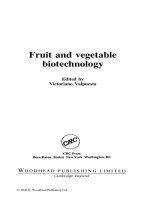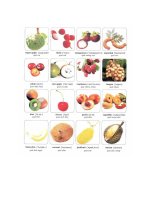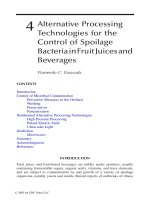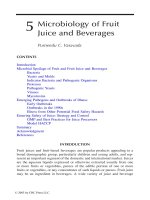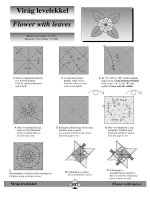Flower fruit injury
Bạn đang xem bản rút gọn của tài liệu. Xem và tải ngay bản đầy đủ của tài liệu tại đây (128.25 KB, 8 trang )
Flower & Fruit Injury
Apple scab
on apple
(right)
Codling moth in apple
Left: Western
flower thrips
feeding injury
on impatiens.
Above: Bean pod mottle virus in soybeans
(left) vs. uninfected beans (right)
Weed Effects
•
•
•
•
•
Weed Groups
Algae (aquatic systems)
Mosses/liverworts (turf & nurseries)
Ferns/horsetails (pastureland, horticultural
crops)
Gymnosperms (rangeland, forests, long-term notill systems)
Angiosperms [monocotyledon & dicotyledon]
(annuals, biennials, perennials)
Weed Impacts
•
•
•
•
Competitive -- yield loss (quantity and quality)
Parasitic effects (cf Norris et al., p 23 – 24)
Mechanical interference with farm implements
Other incidental
– Seed contamination
– Land valuation
– Health & safety (hay fever, toxins, fire hazard)
Comparative Biology of Pests
Chapter 5 is divided into 3 principal segments
1. Concepts in Pest Population Regulation
2. Dissemination, Invasion, and Colonization
Processes
3. Pest Genetics
Comparative Biology of Pests
•
Concepts in Pest Population Regulation
1.
2.
3.
4.
5.
6.
7.
8.
9.
Reproduction
Fecundity & Fertility
Population Generation Time
Longevity & Mortality
Quiescence and Dormancy
Heat Summation & Degree Days
Molting & Metamorphosis
Life Tables
Basic Life Cycle Models
1. Reproduction
Sexual
Good for IPM
Bad for IPM
1.
Can manage
resistance
Mating disrupt.
possible
More plastic, better
able to overcome
tactics
Strain/race
geographically
specific
Can’t overcome
effective controls
1. More inoc. (path &
weed)
2. Faster popn.
growth (all are
reproductive)
2.
Asexual
1.
2.
Note: Many serious species have both sexual & asexual periods or stages.
Individual and Population
Development Time
•
Includes:
2.
3.
4.
5.
•
Fecundity & Fertility
Population Generation Time
Cycles per Season
Longevity and Mortality
Affects management response time
Management Response Time
• The amount of time between when a decision to
control a pest is made and when that control
takes effect.
• Primarily used for rescue treatments.
• Directly affects action thresholds.

